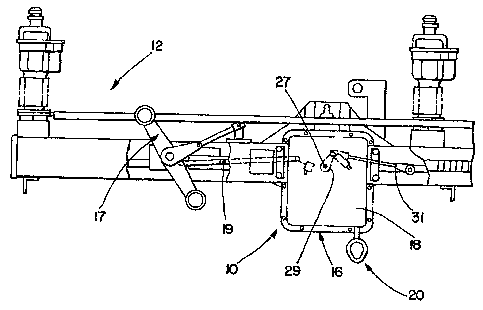Une partie des informations de ce site Web a été fournie par des sources externes. Le gouvernement du Canada n'assume aucune responsabilité concernant la précision, l'actualité ou la fiabilité des informations fournies par les sources externes. Les utilisateurs qui désirent employer cette information devraient consulter directement la source des informations. Le contenu fourni par les sources externes n'est pas assujetti aux exigences sur les langues officielles, la protection des renseignements personnels et l'accessibilité.
L'apparition de différences dans le texte et l'image des Revendications et de l'Abrégé dépend du moment auquel le document est publié. Les textes des Revendications et de l'Abrégé sont affichés :
| (12) Brevet: | (11) CA 2328009 |
|---|---|
| (54) Titre français: | MECANISME DE FONCTIONNEMENT AVEC ENTRAINEMENT D'ENTREE AMELIOREE, POUR COMMUTATEURS ET COUPE-CIRCUITS |
| (54) Titre anglais: | OPERATING MECHANISM WITH IMPROVED INPUT DRIVE ARRANGEMENT FOR SWITCHES AND CIRCUIT INTERRUPTERS |
| Statut: | Durée expirée - au-delà du délai suivant l'octroi |
| (51) Classification internationale des brevets (CIB): |
|
|---|---|
| (72) Inventeurs : |
|
| (73) Titulaires : |
|
| (71) Demandeurs : |
|
| (74) Agent: | OSLER, HOSKIN & HARCOURT LLP |
| (74) Co-agent: | |
| (45) Délivré: | 2009-05-12 |
| (22) Date de dépôt: | 2000-12-12 |
| (41) Mise à la disponibilité du public: | 2002-04-10 |
| Requête d'examen: | 2005-10-20 |
| Licence disponible: | S.O. |
| Cédé au domaine public: | S.O. |
| (25) Langue des documents déposés: | Anglais |
| Traité de coopération en matière de brevets (PCT): | Non |
|---|
| (30) Données de priorité de la demande: | ||||||
|---|---|---|---|---|---|---|
|
Le présent extrait concerne un mécanisme de fonctionnement compact pour commutateurs et coupe- circuits, qui apporte un entraînement d'entrée amélioré, et ce, plus particulièrement à un mécanisme de fonctionnement du type à action et coupure rapide pour les coupe-circuits électriques, c'est-à-dire les commutateurs interrupteurs de charge et les interrupteurs sur défaillance, l'entrée d'entraînement étant capable de fonctionnement soit motorisé soit manuel sans la nécessité d'aucun couplage/découplage ni sélection de mode.
A compact operating mechanism for switches and circuit interrupters provides improved input drive arrangement and more particularly to a quick-make quick-break operating mechanism for electrical circuit interrupters, i.e. load-interrupter switches and fault interrupters, the drive input arrangement being capable of either power or manual operation without the necessity of any coupling/decoupling or mode selection.
Note : Les revendications sont présentées dans la langue officielle dans laquelle elles ont été soumises.
Note : Les descriptions sont présentées dans la langue officielle dans laquelle elles ont été soumises.

2024-08-01 : Dans le cadre de la transition vers les Brevets de nouvelle génération (BNG), la base de données sur les brevets canadiens (BDBC) contient désormais un Historique d'événement plus détaillé, qui reproduit le Journal des événements de notre nouvelle solution interne.
Veuillez noter que les événements débutant par « Inactive : » se réfèrent à des événements qui ne sont plus utilisés dans notre nouvelle solution interne.
Pour une meilleure compréhension de l'état de la demande ou brevet qui figure sur cette page, la rubrique Mise en garde , et les descriptions de Brevet , Historique d'événement , Taxes périodiques et Historique des paiements devraient être consultées.
| Description | Date |
|---|---|
| Inactive : Périmé (brevet - nouvelle loi) | 2020-12-14 |
| Représentant commun nommé | 2019-10-30 |
| Représentant commun nommé | 2019-10-30 |
| Accordé par délivrance | 2009-05-12 |
| Inactive : Page couverture publiée | 2009-05-11 |
| Inactive : Taxe finale reçue | 2009-02-23 |
| Préoctroi | 2009-02-23 |
| Exigences de modification après acceptation - jugée conforme | 2009-02-09 |
| Lettre envoyée | 2009-02-09 |
| Modification après acceptation reçue | 2009-02-02 |
| Un avis d'acceptation est envoyé | 2009-01-13 |
| Lettre envoyée | 2009-01-13 |
| Un avis d'acceptation est envoyé | 2009-01-13 |
| Inactive : Approuvée aux fins d'acceptation (AFA) | 2008-08-26 |
| Modification reçue - modification volontaire | 2008-01-31 |
| Inactive : Dem. de l'examinateur par.30(2) Règles | 2007-08-03 |
| Lettre envoyée | 2005-11-02 |
| Requête d'examen reçue | 2005-10-20 |
| Exigences pour une requête d'examen - jugée conforme | 2005-10-20 |
| Toutes les exigences pour l'examen - jugée conforme | 2005-10-20 |
| Inactive : Page couverture publiée | 2002-04-12 |
| Demande publiée (accessible au public) | 2002-04-10 |
| Lettre envoyée | 2002-02-18 |
| Inactive : Transfert individuel | 2002-01-10 |
| Inactive : CIB en 1re position | 2001-02-06 |
| Inactive : Lettre de courtoisie - Preuve | 2001-01-23 |
| Inactive : Certificat de dépôt - Sans RE (Anglais) | 2001-01-19 |
| Demande reçue - nationale ordinaire | 2001-01-18 |
Il n'y a pas d'historique d'abandonnement
Le dernier paiement a été reçu le 2008-11-21
Avis : Si le paiement en totalité n'a pas été reçu au plus tard à la date indiquée, une taxe supplémentaire peut être imposée, soit une des taxes suivantes :
Les taxes sur les brevets sont ajustées au 1er janvier de chaque année. Les montants ci-dessus sont les montants actuels s'ils sont reçus au plus tard le 31 décembre de l'année en cours.
Veuillez vous référer à la page web des
taxes sur les brevets
de l'OPIC pour voir tous les montants actuels des taxes.
Les titulaires actuels et antérieures au dossier sont affichés en ordre alphabétique.
| Titulaires actuels au dossier |
|---|
| S&C ELECTRIC COMPANY |
| Titulaires antérieures au dossier |
|---|
| ROBERT H. WARD |
| THOMAS O. FANTA |